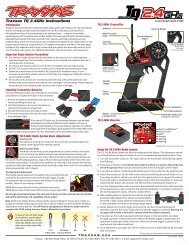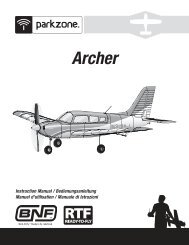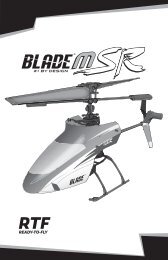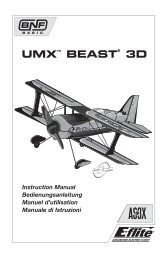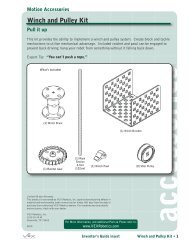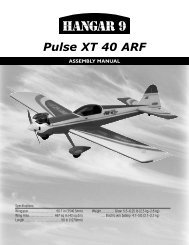You also want an ePaper? Increase the reach of your titles
YUMPU automatically turns print PDFs into web optimized ePapers that Google loves.
INSTRUCTION MANUALYAW-AXIS STABILIZER FOR MODEL HELICOPTER(RATE GYRO)1M23N21902520 Mnl.indd 1 4/7/2009 7:54:59 AM
TABLE OF CONTENTS• Precautions ----------------------------------------------------- 3• Warranty and Repair Service (in U.S.A.) ------------------ 6• Contents -------------------------------------------------------- 7• Specifications -------------------------------------------------- 8• Recommended Servos ---------------------------------------- 9• Replacement and Optional Items --------------------------- 9• Function and Connection Diagram ----------------------- 10• LED Indicator Description ----------------------------------11• Introduction ---------------------------------------------------11• Mechanics Preparation ------------------------------------- 12• GY520 Installation ------------------------------------------ 13• Connecting the GY520 to your Receiver ---------------- 15• GY520 Programming --------------------------------------- 16• Tail Rotor Servo Installation and Setup ------------------ 25• Before Flight Checklist ------------------------------------- 28• Adjustments During the Test Flight ---------------------- 29• Using Normal Mode ---------------------------------------- 30• Setting the Gain --------------------------------------------- 31Technical updates and additional programmingexamples can be found at:www.futaba-rc.com/faq2520 Mnl.indd 2 4/7/2009 7:54:59 AM
PRECAUTIONSWARNING!Failure to follow these safety precautions may result insevere injury to yourself and others.• Read through the entire manual before operating this product.• The GY520 requires 5-10 seconds to initialize when thepower is turned on. Do not move the helicopter and donot move the tail rotor stick during this initializationor the gyro may not initialize properly. Once theinitialization process is complete, the tail rotor servo willmove to the left extent and then to the right extent. Thiswill occur twice. The indicator light will change to solidblue for AVCS Mode or solid red for Normal Mode.BEFORE EACH FLIGHT:• Always check the transmitter and receiver battery voltage toensure they have enough remaining capacity to completethe fl ight.• Verify that the gyro is operating correctly.• Verify that the gyro compensates in the correct directionbefore flight. If the compensation direction is incorrect themodel will pirouette uncontrollably, at a very high rate.• Verify that the gyro is operating in the desired mode.• Verify that the gyro mounting pads are in good condition.• Verify that the gyro wires are not contacting the frame ofthe helicopter.• The servo type parameter within the GY520 must match thetype of servo you are using. Incorrect setting may damagethe GY520 or the servo, possibly resulting in a loss of controlduring fl ight.3520 Mnl.indd 3 4/7/2009 7:55:00 AM
PRECAUTIONS• Only use the GY520 with a 2.4GHz system such as theFutaba FASST system, or a PCM system. Use with a FMsystem is strongly discouraged since interference cancause serious operational problems. In addition to thisthe latest high performance tail rotor servos generateelectrical noise which may also cause interference to anFM receiver.• Always ensure that there is some slack in the gyro cablesto help maximize performance. Always use the suppliedgyro mounting pads to attach the gyro to the helicoptermechanics. Do not use a strap that encompasses the GY520.This may affect the overall performance of the gyro.• Always allow the gyro to adjust to the surroundingenvironmental temperature before fl ight. A large temperaturechange during use will cause drift and other operational issues.• The GY520 uses a conductive resin case to preventelectromagnetic interference. Do not allow anything to touchthe gyro case as it may cause a short circuit.• If you are switching between Normal Mode and AVCS Modein flight, please keep in mind that you must have the gyrore-learn the center position after making a trim change withinthe transmitter. To memorize the new center position simplyflip the gain switch on the transmitter three times betweenNormal Mode and AVCS Mode within one second. The tailrotor servo will center indicating that the new center positionhas been memorized.• When the GY520 is used in Normal Mode, tail rotorcompensation or revolution mixing must be used withinthe transmitter.4520 Mnl.indd 4 4/7/2009 7:55:00 AM
PRECAUTIONS• When operating the gyro in AVCS Mode, all tail rotorcompensation and revolution mixing must be disabled andany tail rotor offsets for fl ight modes must be disabled.• When the GY520 is operated in AVCS mode the tail rotorservo will not center when the stick is released. This isnormal operation for AVCS mode. The servo may also moveto the extent while the model is being carried out to the fl ightline. Before take off, you must center the tail rotor servo bymoving the tail rotor stick full left, then full right, back to fullleft and then allow the stick to center within one second. Youcan also visually center the tail rotor pitch slider by using thetail rotor stick.• Do not drop the GY520 onto a hard surface or subject theGY520 to a strong shock as this may damage the sensor.Always use the supplied mounting pads or the Futabareplacement mounting pads available from your localhobby dealer.• Always exit programming mode before attempting to fl ythe model.• Do not use any type of priority mixing or gain reductionmixing on the GY520.5520 Mnl.indd 5 4/7/2009 7:55:00 AM
WARRANTY & REPAIR SERVICE (IN U.S.A.)If any difficulties are encountered while setting up or operatingyour GY520, please consult the instruction manual first. Forfurther assistance you may also refer to your hobby dealer,or contact the Futaba Service Center at the web site, fax ortelephone number listed below:www.futaba-rc.com or www.hobbyservices.comFax (217)-398-7721, Tel (217) 398-0007If you are unable to resolve the issue, pack the system in itsoriginal container with a note enclosed and a thorough, accuratedescription of the difficulty. Include the following in your note:• Symptoms (including when the problem occurred)• System (Transmitter, Receiver, Servos and model numbers)• Model (Model name)• Model numbers and quantity• Your Name, Address and Telephone numberSend the respective items to the authorized Futaba ServiceCenter Address below:Futaba Service Center3002 N Apollo Drive Suite 1Champaign, IL 618226520 Mnl.indd 6 4/7/2009 7:55:00 AM
CONTENTSGY520 GyroMounting Pads2mm Thick (two)3mm Thick (two)Adjustment ScrewdriverDamping andShield PlateExtensionsTail Rotor Extension (Black)Gain Extension (Red)7520 Mnl.indd 7 4/7/2009 7:55:00 AM
RECOMMENDED SERVOS250 – 450 Sized ElectricFutaba S9257 EP Heli Digital (280Hz/1520μS): FUTM0667.30 – .91 Size HelicoptersFutaba S9254 Digital Servo Heli (280Hz/1520μS): FUTM0224Futaba S9256 Digital Hi Speed (560Hz/760μS): FUTM0226Futaba BLS251 Brushless Heli Servo (560Hz/760μS): FUTM0521REPLACEMENT & OPTIONAL ITEMSFutaba PC Interface CIU-2 for GY520: FUTM0951FSH64 GY520 Extension 200 mm (2): FUTM4664FSH65 GY520 Extension 350 mm (2): FUTM4665FSH66 GY520 Extension 55 mm (2): FUTM4666FSH67 GY520 Extension 80 mm (2): FUTM4667FSH68 GY520 Extension 130 mm (2): FUTM4668FSH69 GY520 Mounting Pad 2x22x22 mm (10): FUTM4669FSH70 GY520 Mounting Pad 3x22x22 mm (10): FUTM4670FSH71 GY520 Shield Plate 1x22x22 mm (3): FUTM46719520 Mnl.indd 9 4/7/2009 7:55:02 AM
FUNCTIONS & CONNECTIONSLED IndicatorButtonTail Rotor ServoGainChannelTail RotorChannel10520 Mnl.indd 10 4/7/2009 7:55:02 AM
Slow Flash: 1/2 Second or longerFast Flash: 1/4 Second or shorterLED INDICATOR DESCRIPTIONCONDITION LED INDICATOR DESCRIPTIONInitialization Slow Red Flash No Receiver Pulse or Sensor ErrorSlow Blue FlashFast Blue FlashWarm-UpSensor InitializationOperating Solid Blue Normal Mode, Ready for FlightSolid RedSlow Violet FlashFast Blue or Red FlashAVCS Mode, Ready for FlightOffset from the Neutral PositionGyro is RotatingINTRODUCTIONThe Futaba ® GY520 is the smallest and lightest heading holdAVCS gyro available today. Its cutting-edge MEMS (Micro ElectroMechanical System) sensor design, ultra high-speed processingspeed and advanced PID control algorithm put it a quantumleap ahead of all other heading hold gyros in size, weight andperformance. The GY520 has been optimized to work with smallelectric models and larger nitro (.30 through .91) sized helicopters.11520 Mnl.indd 11 4/7/2009 7:55:03 AM
MECHANICS PREPARATIONSWARNING!• Newer high end servos and other radio equipment arecapable of placing large demands on the power systemsin use today. When using a regulator you must ensurethat the regulator is capable of delivering the currentdemands of the equipment you have selected. In additionto this make sure the wiring and switch you haveselected are capable of handling high current draws.• Even though the GY520 is a high performance gyro it will benecessary to ensure that the helicopter mechanics are alsoin optimum operating condition. Please use the guidelinesbelow and address all issues before installing and test fl yingthe GY520.• The GY520 must be used with a rigid tail rotor drive system.Any modern torque tube or belt drive system should beadequate. Do not attempt to fly the GY520 using a wiredriven tail rotor system.• Always ensure the drive gears, torque tube, pulleys, belt,bearings and shafts are in proper working condition. If any ofthese items are damaged or worn they must be replaced.• The linkage rod, tail rotor bell crank, pitch slider and tailrotor grips must operate without friction to obtain the bestperformance from the GY520. If any binding is present itmust be fi xed before the helicopter can be fl own. Binding inthe tail rotor control linkage will decrease the performance ofthe GY520 gyro and this may also shorten the servo lifespan.Please take the time now to ensure the tail rotor system onyour helicopter is working correctly, without friction or binding.• Vibration will affect the gyro’s overall performance. Allrotating components on the helicopter should be balancedto minimize vibrations in flight. Ensure that your motor isrunning smooth and all vibrations have been addressedbefore installing and test fl ying the GY520.12520 Mnl.indd 12 4/7/2009 7:55:03 AM
GY520 INSTALLATIONThe gyro should be mounted on a rigid platform, at least6in [152mm] away from a Nitro Engine. It is not necessaryto mount the gyro near the main shaft of the helicopter butit is very important that the mounting area chosen is rigid.Please refer to your helicopter manufacturer’s instructions forrecommended mounting locations.Installing the gyroThe GY520 is supplied with two 2mm Mounting Pads, two3mm Mounting Pads, and one 1mm Damping and ShieldPlate to help accommodate several installation methods. Mostelectric helicopters with minimal vibrations can use one 2mmmounting pad to mount the gyro onto the Gyro Mount. If theGY520 is mounted near the ESC, near a servo, or near the tailrotor belt we highly recommend using two 2mm MountingPads and the steel Damping/Shield Plate to help preventelectromagnetic interference from reaching the gyro.Recommended Installation for Smaller Electric Helicopters(250, 450, and 500 size helis)2mm Mounting PadGyro Mount13520 Mnl.indd 13 4/7/2009 7:55:03 AM
GY520 INSTALLATIONRecommended Installation for Larger Electric Helicoptersand All Nitro HelicoptersDamping andShield Plate2mm or 3mmMounting PadsGyro MountOn smaller electric helicopters it is best to mount the gyro usingone 2mm mounting pad. When mounting the gyro in a largerelectric or .50 through .91 size nitro helicopter we recommendusing two 3mm Mounting Pads and the Damping/Shield Plate.TROUBLESHOOTINGIf you experience erratic gyro operation (drifting, not holdingwell or inconsistent pirouette rate), please follow thetroubleshooting tips listed below.1. Always verify that your model’s tail rotor control and drivesystem are working correctly.2. Electromagnetic interference could affect the gyro ortail rotor servo. Use the metal damping and shield plateor mount the gyro in a different location, away from theelectronic speed control, servos and drive motor.3. The trouble may be caused by vibration. Verify that yourhelicopter’s components are balanced. If problems persist,try mounting the gyro in a different location. Variouscombinations of the gyro mounting tape may help to maskthe issue.14520 Mnl.indd 14 4/7/2009 7:55:03 AM
CONNECTING THE GY520 TO YOUR RECEIVERTail RotorServoRed: GainChannelBlack:Tail RotorChannelConnect the supplied extensions to the GY520 connecter block asindicated. Route the wires through the helicopter mechanics andconnect them to the appropriate receiver channels. To determinethe appropriate receiver channels please check your transmitter’sinstruction manual. Using a piece of double sided tape, mountthe GY520 connector block onto the helicopter, ensuring thatyou leave some slack in the wire leading to the gyro. Using wiremounts, wiring fixtures molded into the helicopter, or hook andloop material, route the extensions to the receiver. Ensure that theextensions leading to the receiver cannot become entangled inrotating components and make sure the extensions are not rubbingagainst metal or carbon fiber which may damage the wires.Once the power system is installed into your helicopter pleasemove onto the next section to learn how to program the gyro.15520 Mnl.indd 15 4/7/2009 7:55:03 AM
GY520 PROGRAMMINGButtonEntering Programming ModePress and hold the button on the side of the GY520. After3 seconds the LED indicator will momentarily change to violet.Release the button and the gyro will begin flashing once persecond. The color shown is the option selected for the 1stparameter [Servo Type]. For example, if you see one Blue Flashthen the [Servo Type] is set to Digital 1520 S. If you see oneRed Flash then the [Servo Type] is set to Digital 760 S servo.The number of flashes is the parameter number you are viewingand the color of the LED indicates the setting that has beenselected. Please see the GY520 Parameters and Settings Table.Changing the setting within a parameterTo move to the next setting within a parameter, quickly (lessthan one second) press and release the button on the gyro. TheLED will begin flashing rapidly. This indicates that the gyroneeds confirmation of the change. While the LED is flashing,rapidly press and release the button again to confirm thechange. The confirmation request flash will last one second,after this period of time the gyro will return to the parametermenu without making a change. Always ensure that the changehas taken place by counting the number of flashes and verifythe color of the indicator LED.Moving to the next ParameterPress and continue to hold the button on the side of the GY520.After 2 seconds the LED indicator will momentarily change toviolet. Release the button and the gyro will move to the nextparameter. The number of flashes will change to reflect this.16520 Mnl.indd 16 4/7/2009 7:55:04 AM
GY520 Parameters and Settings TableGY520 PROGRAMMINGPARAMETER SETTING LED INDICATION1. Servo Selection2. Gyro CompensationDirection3. Servo Limits4. Flight Mode5. Response6. Data ResetDigital 1520μS Servo*Digital 760μS ServoAnalog ServoNormal*ReverseF3C Mode*3D ModeStandard*FastSlow(Resets Settings 1 – 5)* Default SettingBlue, 1 FlashRed, 1 FlashViolet, 1 FlashBlue, 2 FlashesRed, 2 FlashesRed, 3 FlashesBlue, 4 FlashesRed, 4 FlashesBlue, 5 FlashesRed, 5 FlashesViolet, 5 FlashesBlue, 6 Flashes17520 Mnl.indd 17 4/7/2009 7:55:04 AM
GY520 PROGRAMMINGParameter 1: Servo Type [1 FLASH]Select the appropriate setting for the servo you are using.LED INDICATORSERVO TYPESERVO COMPATIBILITYFutaba S9650 EP Heli Digital ServoBlue, 1 FlashDigital 1520μS Servo*Red, 1 FlashDigital 760μS ServoViolet, 1 FlashFutaba S9257 EP Heli Digital ServoFutaba S9253 Digital ServoFutaba S9254 Digital ServoAny digital servo capable of a 280 Hz update rate.Futaba S9251 Digital High Speed ServoFutaba S9256 Digital High Speed ServoFutaba BLS251 Brushless Heli ServoAll analog (non-digital) servos.* Default SettingWARNING!The servo type parameter within the GY520 must match thetype of servo you are using. Incorrect setting may damage theGY520 or the servo, possibly resulting in a loss of control ofthe model during fl ight.18520 Mnl.indd 18 4/7/2009 7:55:05 AM
GY520 PROGRAMMINGParameter 2: Gyro Compensation Direction [2 FLASHES]LED INDICATORRed, 2 FlashesBlue, 2 FlashesDESCRIPTIONNormal Compensation*Reverse Compensation* Default SettingWARNING!Verify that the gyro compensates the correct direction beforefl ight. If the compensation direction is incorrect the model willpirouette uncontrollably at a very high rate.This parameter controls which direction the gyro will compensatewhen the helicopter rotates. Once the tail rotor linkage is connectedto the servo, pick the helicopter up by the main shaft and rotatethe mechanics counter-clockwise. The gyro should compensateby adding clockwise rotation pitch to the tail rotor blades. If thegyro compensates by adding counter-clockwise rotation pitch tothe tail rotor blades then it will be necessary to reverse the GyroCompensation Direction setting.19520 Mnl.indd 19 4/7/2009 7:55:05 AM
GY520 PROGRAMMINGParameter 3: Servo Limits [3 FLASHES]LED INDICATORRed, 3 FlashesBlue, 3 FlashesDESCRIPTIONLimit Testing ModeSet limit using tail rotor stick.The Servo Limit parameter is used to set the mechanical limits for thetail rotor servo. To obtain the highest performance it is recommendedto adjust the servo arm length to set the mechanical limits and thenuse the servo limits parameter to make small adjustments.WARNING!• To prevent damage to the servo always perform limit setupwith the tail rotor linkage disconnected and simply hold thelinkage over the linkage ball to verify settings.• While in the servo limits parameter the gyro no longerfunctions. Always ensure that the gyro is functioning correctlyand it is not in the servo limits parameter before flyingthe helicopter.Setting the servo limits:Go to the SERVO LIMITS parameter. While in the servo limitsparameter the gyro compensation no longer functions and the tailrotor servo will always center. This can be used to set the centeringposition for the tail rotor linkage and the tail rotor stick can bemoved to verify that the limits are set correctly. While in the servolimits parameter the tail rotor stick is 150% more effective tocompensate for any tail rotor AFR or D/R adjustments made withinthe radio. Please do not be concerned if the tail rotor servo reachesits limit before the tail rotor stick reaches its physical limit.20520 Mnl.indd 20 4/7/2009 7:55:05 AM
GY520 PROGRAMMINGWARNING!If one of the servo limits is set to a position less than 50% of thetotal throw, the LED on the gyro will turn red. When the LED isred, you will not be able to move to the next limit setting or exitthe limit setting parameter. If the current value is greater than50% then the LED will be blue and the setting is acceptable.Quickly press and release the button once to enter limit settingmode. The LED will flash quickly and the tail rotor servo will travelto the set limit. When the transmitter’s tail rotor stick is moved tothe left or to the right the servo limit will increase or decrease. Holdthe tail rotor linkage over the linkage ball and adjust the servo limitusing the tail rotor stick until no binding occurs. If the LED turnsred, then the travel value is less than 50% and this is not acceptable.Please decrease the servo arm length to reduce throw.Quickly press and release the button once. If the limit is acceptablethe LED will momentarily change to Violet and the servo willtravel to the opposite limit setting. Hold the tail rotor linkage overthe linkage ball and adjust the servo limit using the tail rotor stickuntil no binding occurs. If the LED is flashing red then the travelvalue is less than 50% and this is not acceptable. Please decreasethe servo arm length to reduce throw.Quickly press and release the button once to return to the SERVOLIMITS parameter. If the limit settings are accepted the LED willmomentarily change to violet. You can now move the tail rotor stickagain to verify that the settings are correct. If you need to adjust thesettings again simply repeat the above procedure to adjust the servolimit settings.21520 Mnl.indd 21 4/7/2009 7:55:06 AM
GY520 PROGRAMMINGParameter 4: Flight Mode [4 FLASHES]WARNING!Always make small (1%) adjustments to the tail rotor D/R orEPA once the value exceeds 100%. Over 100%, it is possibleto exceed the sensor’s Angular Velocity Sensing Range(+/- 800° per second). The gyro will then no longer controlthe pirouette rate or consistency. The pirouette rate will beextremely fast.If you experiment with the ultra-fast pirouette rate, makesure that your fl ight battery and fuel tank are secure. Also becertain that your model’s tail rotor drive train is up to the task.LED INDICATOR/MODEBlue, 4 FlashesF3C Flight Mode*Red, 4 Flashes3D Flight ModeDESCRIPTION450 deg/sec pirouette rate at 100% D/RSofter pirouette starts and stops.720 deg/sec pirouette rate at 100% D/RAggressive pirouette starts and stops.* Default SettingSelects the flight mode. Always try the F3C flight mode first and ifyou determine that the gyro is not aggressive enough, then try the 3Dflight mode. The F3C Flight Mode will satisfy most pilots.22520 Mnl.indd 22 4/7/2009 7:55:06 AM
GY520 PROGRAMMINGParameter 5: Gyro Response Rate [5 FLASHES]LED INDICATORBlue, 5 FlashesRed, 5 FlashesViolet, 5 FlashesDESCRIPTIONStandard Response*Fast ResponseSlow Response* Default SettingSets the gyros response rate. The standard setting is acceptablefor most helicopters. We recommend trying this setting first. Onextremely small or lightweight helicopters with high performancetail servos and high performance tail setups, the Fast response ratemay work better. The slow response rate should be used on largerand heavier scale models. This setting will affect the pirouette rate,pirouette starts and stops, and the gyro compensation responseas well.23520 Mnl.indd 23 4/7/2009 7:55:06 AM
GY520 PROGRAMMINGParameter 6: Data Reset [6 FLASHES]Restores the gyro to the factory default settings. It will be necessaryto reprogram all parameters again before flying the model.PARAMETERDEFAULT SETTING1. Servo Type Digital 1520μS2. Gyro Compensation Direction Normal3. Servo Limits 100% / 100%4. Flight Mode F3C5. Gyro Response StandardTo perform the Data Reset:Quickly press and release the button on the gyro. The gyro LED willbegin flashing quickly requesting confirmation of the Data Reset. Toconfirm the Data Reset the gyro button must be quickly pressed andreleased 3 times, within 2 seconds. Once the data reset is performedthe gyro will automatically return to the Servo Type Selection [Blue,1 Flash] parameter.Exiting Programming Mode:Once you have completed setting up the parameters simply turn thereceiver power off.24520 Mnl.indd 24 4/7/2009 7:55:06 AM
TAIL ROTOR SERVO INSTALLATION AND SETUPFollowing your transmitter instructions, program yourtransmitter as follows:❏ Enable the gyro function within the transmitter.❏ Set the gyro mode to AVCS (GY) within the transmitter.❏ Set the remote gyro gain to 70% AVCS in the transmitter forthe Normal and Hold flight conditions and use 40% AVCS forall idle up conditions. See “Setting The Gain” section later inthis manual for more details.❏ Set the Tail Rotor ATV/EPA to 100% for both left and right.❏ Set D/R to 75% for both left and right. This will reduce themaximum pirouette rate. Make adjustments to these valuesonce the initial test flight has been completed.❏ It is recommended that you run 30% softening expo on the tailrotor channel.WARNING!Do not connect the tail rotor servo to the gyro until the servotype has been selected. Operating the servo using theincorrect setting may damage the GY520 or the servo.Once these steps are completed, turn the receiver power on andallow the gyro to initialize. Follow the instructions within the“GY520 Programming” section of the manual and select theServo Type that matches the servo you have chosen to use. Powerdown the receiver for now.25520 Mnl.indd 25 4/7/2009 7:55:07 AM
TAIL ROTOR SERVO INSTALLATION AND SETUP❏ Install the tail rotor servo into the mechanics and connect theservo to the gyro. Remove the servo arm screw from the servo.Turn the receiver power on and allow the gyro to initialize.Enter programming mode and go to parameter 3 – Servo Limits[Red, Three Flashes]. While in the servo limits parameter theservo will remain centered.90˚❏ Place an appropriate servo arm onto the servo and ensure that itis perpendicular to the tail rotor pushrod as shown. Remove theunused sides of the servo arm.❏ Install the control ball supplied with your helicopter onto theservo arm. For smaller electric helicopters (250, 300, 450and 500 size) we recommend placing the ball 7.5mm fromcenter. For larger electric models or nitro powered models werecommend placing the ball 13.5mm from center. Once thecontrol ball has been installed place the arm back onto the servoensuring that it is perpendicular to the tail rotor pushrod. Installthe servo arm screw.26520 Mnl.indd 26 4/7/2009 7:55:07 AM
TAIL ROTOR SERVO INSTALLATION AND SETUPSmaller Electric Helis(250, 300, 450 and 500)7.5mm13.5mmLarger Electric andAll Nitro Helis❏ Follow the instructions within the GY520 programming sectionand set the servo limits for the tail rotor servo. Hold the tailrotor linkage over the linkage ball to avoid damaging the servo.Once the limits are set you can place the linkage onto thelinkage ball. When using AVCS mode the optimum setup is tohave 0° of pitch with the tail rotor servo centered and use all ofthe available pitch range available in the tail without binding.❏ Turn the receiver power off to exit programming mode and thenturn the receiver power back on. Once the gyro has completedinitialization move the tail rotor stick to the right on thetransmitter and verify that right (clockwise rotation) tail rotorpitch is inputted to the tail rotor blades. If left tail rotor pitchis inputted to the tail rotor blades, then it will be necessary toreverse the tail rotor channel in the transmitter.❏ Pick the helicopter up by the main shaft and rotate the mechanicscounter-clockwise (from the top). The gyro should compensateby adding clockwise rotation pitch to the tail rotor blades. If thegyro compensates by adding counter-clockwise rotation pitch tothe tail rotor blades then it will be necessary to reverse the GyroCompensation Direction setting within the gyro (refer to theGY520 Programming section earlier in this manual).If you are going to fly AVCS Heading Hold mode exclusively,then the gyro setup is now complete.27520 Mnl.indd 27 4/7/2009 7:55:07 AM
BEFORE FLIGHT CHECKLIST❏ Transmitter and Receiver batteries are fully charged.❏ The gyro mounting pads are in good condition.❏ The gyro wiring has some slack in it and all wires are clearof the main frame.❏ Power on the transmitter and receiver. Allow the gyroto initialize.❏ The GY520 servo type parameter matches the servo youare using.❏ The Tail rotor servo arm is perpendicular to the pushrodand the pitch slider is centered.❏ The servo does not bind when full left or full right tail rotoris applied.❏ The gyro is operating in the correct mode (AVCS orNormal).❏ The tail rotor stick operates the tail rotor the correctdirection.❏ The gyro compensates the correct direction when thehelicopter is rotated.❏ The gain is set correctly and the gyro operates in the correctmode (AVCS or Normal) in every flight condition.28520 Mnl.indd 28 4/7/2009 7:55:08 AM
ADJUSTMENTS DURING THE TEST FLIGHTWARNING!Always make small (1%) adjustments to the tail rotor D/R orEPA once the value exceeds 100%. Over 100%, it is possibleto exceed the sensor’s Angular Velocity Sensing Range(+/- 800° per second). The gyro will then no longer controlthe pirouette rate or consistency. The pirouette rate will beextremely fast.If you experiment with the ultra-fast pirouette rate, makesure that your fl ight battery and fuel tank are secure. Also becertain that your model’s tail rotor drive train is up to the task.The Tail Rotor AFR or D/R function within the transmitter is usedto adjust the pirouette rate of the helicopter. For example at 100%D/R, with the gyro set to F3C mode, the helicopter will achieve a450 deg/sec pirouette rate. If you would like the model to pirouettefaster, then increase the AFR or D/R. If you would like the modelto pirouette slower, then decrease the AFR or D/R.The gain should be raised until the tail begins to oscillate quickly(also called Tail Wag). Once this point has been achieved, reducethe gain by a couple of percent and test fly the model again. Checkand set the gain for each flight mode. Typically the gain will belower for the Idle up 1 and Idle up 2 flight modes due to the higherhead speed being used. The gain for the Hold condition can also bemuch higher than other flight modes since the head speed is lowerand the engine vibration is minimized.The tail rotor ratio, tail rotor pitch range and tail blade length playa large part in achieving optimum tail rotor performance. The gainvalue can vary drastically from model to model and the exact valueshould not play a part in the evaluation of the gyro’s performance.How the gyro operates during flight is the only concern of ours.29520 Mnl.indd 29 4/7/2009 7:55:08 AM
USING GY520 NORMAL MODEMost pilots today are using AVCS Mode. If you are just startingout, it is recommended that you use AVCS Mode exclusively fromthe start. Normal Mode is rarely used today due to the performancebenefits of AVCS mode. When using AVCS mode all trimming of thetail is automatically handled by the gyro. If you should decide to useNormal Mode than all trimming and mixing must be setup by you.If you will be using the Normal Mode (also referred to as RateMode) then a few changes to the setup will be necessary. The tailrotor should be set to 10 degrees of tail rotor pitch (to counteracttorque) when the tail rotor servo is centered. With clockwiserotating main rotor blades this means 10 degrees of right tail rotorpitch will be necessary to counteract torque. In addition to this itwill be necessary to use the tail rotor compensation or revolutionmixing functions of your transmitter to help counteract torque.Please see your transmitter instruction manual for more informationon how to set this up.If you decide to switch between Normal Mode and AVCS Modein flight, you must have the gyro re-learn the center position aftermaking a trim change within the transmitter. To memorize the newcenter position simply flip the gain switch on the transmitter threetimes between Normal Mode and AVCS Mode within one second.The tail rotor servo will center, indicating that the new centerposition has been memorized.30520 Mnl.indd 30 4/7/2009 7:55:08 AM
SETTING THE GAINMost modern computer transmitters will have a gyro functionbuilt into them. If this is the case, please refer to your transmitter’sinstruction manual. Most modern gyro functions will allow you toset the mode of operation and the gains for several flight conditions.The use of these functions is strongly encouraged. Shown below is arecommendation of settings:Recommended GyroFunction Settings:Switch: ConditionType: GY or AVCSGain ValuesNormal: 70% A (AVCS)Idleup 1: 40% A (AVCS)Idleup 2: 40% A (AVCS)Hold: 70% A (AVCS)2-PositionSwitchGyro Mode NORMAL AVCSGain ChannelATV or EPA70% 70%GAIN %100%50%ANormal SideBAVCS SideIf your transmitter does nothave a Gyro function builtin then it will be necessaryto use the ATV or EPA function to control the gain. The Gyro Gainchannel will generally be assigned to a switch which provides twogain values. Simply set the ATV or EPA for the gyro channel to thedesired gain value and set the Gain Switch to the desired mode ofoperation. Unfortunately since you will only have one gain valueavailable it will be necessary to use the lowest value needed (forexample Idleup 2). When using this method of controlling thegain, one direction of the switch will be AVCS mode and the otherdirection of the switch will be Normal mode. Always ensure the gyroswitch is set to the desired mode before flying. Do not accidentallychange the gyro switch in flight.310%+100% Neutral0%-100%520 Mnl.indd 31 4/7/2009 7:55:08 AM
Entire Contents Copyright © 2009520 Mnl.indd 32 4/7/2009 7:55:08 AM



